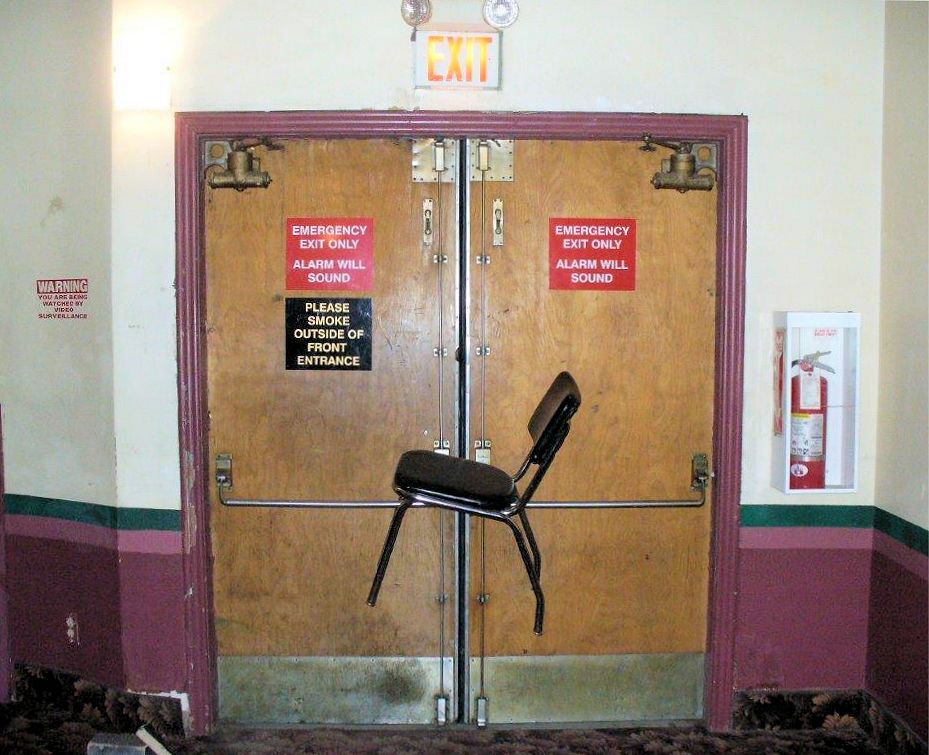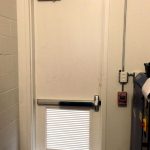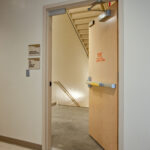Today’s Quick Question came up again last week:
Do current model codes prohibit the use of crossbar style panic hardware?
The short answer is no – the model codes do not prohibit crossbar panics, but I’m curious about whether you have seen any change in your state or local codes.
The slightly longer answer…
The three common types of panic hardware are crossbar style, touchpad style, and recessed (all shown on the panic hardware page of iDigHardware). There is also tubular panic hardware that is often used on all-glass doors.
One of the disadvantages of crossbar panic hardware is that it is easier for someone to prevent egress by chaining the panic hardware together, or using some other creative method (see above). With that said, where there’s a will, there’s a way, and egress can be defeated in favor of security or convenience – regardless of the type of hardware.
The model codes require panic hardware in certain locations, depending on the use group/occupancy classification and the occupant load. Panic hardware is defined in the I-Codes as: A door-latching assembly incorporating a device that releases the latch upon the application of a force in the
direction of egress travel. The type of “device” used to release the latch is not further defined by the model codes, except that the actuating portion must measure at least half the width of the door.
For me, the deciding factor is the listing. Both the I-Codes and the NFPA Codes require panic hardware to be listed in accordance with UL 305, Panic Hardware. If a product is being installed on a door that is required to have panic hardware, I would only specify hardware that is listed to UL 305. It could have a crossbar, touchpad, tubular bar, or some other device that measures half the width of the door, depending on aesthetic preferences, electrical options, door material, etc.
As required for all types of door hardware, the door must be unlatched with one releasing motion (with a couple of exceptions), with one hand and with no special knowledge or effort, without the use of a key, tool, special knowledge or effort, and without tight grasping, pinching, or twisting of the wrist. The mounting height and operable force limitations must also be met.
Have you seen any state or local codes prohibiting crossbar style panic hardware?
You need to login or register to bookmark/favorite this content.










I know of no codes but have seen some standards and it was a topic back when NFPA3000 was being developed. But since it has been proven all of the bars can be disabled it is kind of moot.
Hi
Do you cover Calif codes?
I constructed and completed a Health club facility in Oct 2019. It was permitted in 2010. We were able to maintain and keep the original 2010 permit approval date. At the time of finalizing, our environmental health inspector was not accepting the double storefront doors accessing from a party room into the pool deck. The access is from pool to party room . The panic device is set at a height of 36″+-. We understand pool access gate codes 3119B.2 requires locksets to be mounted at 42″+ for a higher restricted access But this door panic devices leads away, exits from the pool. The pool room has a total of 6 doors. 2 doors Exit (swing out) to outside the building. This double door swings out, away from pool and into the party room. 3 doors lead into (swing in) the pool area. These 3 doors are men’s and women’s locker rooms and a hallway path of travel door which are compliant to the 42″ height and lockable. (Restricts access) The storefront door into the party room has been a major point of contention for our health inspector, from day 1. He cannot under stand the panic device on the storefront system is located at the 36″ height for a person to depress with their waist or a child is able to use easily for exiting. Exactly like the 2 Exit doors to the Exterior. The party room panic devices are on pool side and is only leading into the party room. When the doors close they latch locked. Unless someone undogs the panic device latch. Only then can the doors be opened by pulling on the handles on party room side. Otherwise the doors are to be locked/latched with the panic device.
Our Architect has since retired. But, he told me he did a lot of research before drawing in the double doors. He found no code restricting what he designed. The health inspector is demanding the double doors be removed and a solid – glass wall installed into the existing doorway.
In order to get a Temporary Certificate of Occupancy in 2019. At the health inspectors request, I screwed a block of wood into the concrete slab on the party room side of the double doors restricting all access and use of this double storefront door.
On our final walk through to secure the final CofO, with building inspector , Health dept. inspector and Fire Marshall. The health inspector beat the panic device height into the ground. We continued to inform him the device height does not allow access into the pool. We could not convince him. He could not understand. He was dead set on the 3119B.2 code of 42″ height for locksets. Our Fire Marshall got so upset he blew up stating the Contractor has constructed the facility to code and that he will accept and sign off on the doors as the are installed .
Fast forward 2024
The same health inspector has now May 13 2024, closed the pool until the owners remove the storefront doors into the party room and fill it in with solid panes of glass or whatever they propose. The Owners have to write a proposal for him to accept first.
I am wondering if we have any legal stand with this guy?
He is only citing the pool gate code 3119B.2 Which covers lockset height accessing a pool
I have the County permitted set of plans A picture is worth 1000 words. I can send a pdf if you have time to look at it?
Brendan McKenny
McKenny & Sons Inc.
Eureka Calif 95501
707 498 7681 cell
The Club at MillCreek
1570 Betty Court
McKinleyville CA 95519
Hi Brendan –
If you send me a PDF I will either take or look or I will send it to my California coworkers for their help (I’m on the road this week). My email address is lori.greene@allegion.com.
– Lori
Lori,
Beyond the exit devices, I’m more curious about another feature: are those flush bolts???
Hi Andy –
Yes, those are flush bolts installed in the face of the doors. EEK.
– Lori
The only restriction related to types of panic hardware are due to egress widths and depending on configuration on a single door with some of the devices like an 88 or 55 Von Duprin when the device is not dogged down the distance it stands off the door near the hinge on a door limited to 90-110 degrees and mullion or weather sealing options you may not be able to get the required egress width without having a door width over 3′.